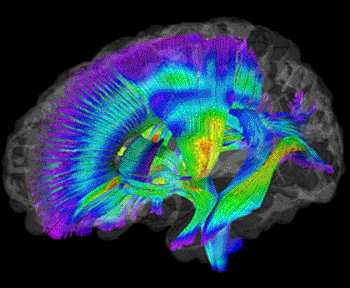DTI MRI Scans Reveal Brain Differences in Six-Month-Old Autistic Infants
By MedImaging International staff writers
Posted on 28 Feb 2012
New findings suggest that autism does not appear suddenly in young children, but instead develops over time during infancy. This discovery is significant because it brings scientists one-step closer to developing a biomarker to assist with very early diagnoses for autism spectrum disorders. Posted on 28 Feb 2012
A new study from the Infant Brain Imaging Network found significant differences in brain development starting at age six months in high-risk infants who later develop autism, compared to high-risk infants who did not develop autism. “It’s a tremendously exciting finding,” said Sarah Paterson, PhD, director of the Infant neuroimaging lab at the Center for Autism Research at The Children’s Hospital of Philadelphia (CHOP; PA, USA). “We found that the brains of the children who developed autism were markedly different even prior to the onset of behavioral symptoms of autism. Thus, our findings, while requiring replication, are a very important first step towards identifying a biomarker for autism risk. This would enable specialists to diagnose autism much earlier than what is currently possible through behavioral observations.”

Image: A visualization of white matter pathways in the brains of infants at-risk for autism. Warmer colors represent levels of white matter organization and development (Photo courtesy of Jason Wolff).
The study also suggests that autism does not appear abruptly in young children but instead develops over time during infancy, noted the researchers. Intensive early intervention has been shown to improve outcomes in children with developmental delays and autism. “This research raises the possibility that we might be able to intervene even before a child is six months old, to blunt, or prevent the development of some autism symptoms,” said Dr. Paterson.
The study was published February 17, 2012, in the American Journal of Psychiatry. These findings are the latest from the ongoing Infant Brain Imaging Study (IBIS), which is led at CHOP by Dr. Paterson and Robert Schultz, PhD, who are coauthors on this study.
Participants in the study were 92 infants believed to be at high risk for ASD, because they all have older siblings with autism. Each infant had diffusion tensor imaging (DTI)--a type of magnetic resonance imaging (MRI)--at six months and behavioral assessments at 24 months. Most of the children also had additional brain imaging scans at either or both 12 and 24 months.
At 24 months, 28 infants (30%) met criteria for ASDs while 64 infants (70%) did not. The two groups differed in white matter fiber tract development--pathways that connect brain regions--as measured by fractional anisotropy (FA). FA measures white matter organization and development, based on the movement of water molecules through brain tissue.
This study examined 15 separate fiber tracts, and found considerable differences in FA growth trajectories in 12 of the 15 tracts between infants who did develop autism versus infants who did not. Infants who later developed autism had elevated FA at six months but then experienced slower development over time. By 24 months of age, infants with autism had lower FA values than infants without autism did.
The findings come on the heels of a recent study from London, UK, which found that infants at high risk for autism who were later diagnosed with the condition showed different brain responses from low-risk babies, or from high-risk babies that did not develop autism when shown images of faces looking at or away from the baby. Dr. Paterson reported that the two findings support one another and are promising evidence that scientists are on the right path towards finding markers for identifying autism much earlier than is currently possible.
In addition to the Center for Autism Research at CHOP, other institutions that took part in the study include the University of North Carolina (Chapel Hill, USA), University of Utah (Salt Lake City, USA), Washington University in St. Louis (MO, USA), University of Washington (Seattle, USA), McGill University (Montreal, Canada), and the University of Alberta (Edmonton, Canada).
The Center for Autism Research (CAR) is a collaborative effort between several dozen scientists across multiple departments at the Children’s Hospital of Philadelphia. CAR’s goals are to identify the causes of autism spectrum disorders (ASD) and to use that knowledge to develop more effective treatments. CAR conducts research studies for infants at risk for being diagnosed with ASD (due to having a sibling already diagnosed) as well as toddlers, school-aged children, and adults on the autism spectrum.
Related Links:
Center for Autism Research at The Children’s Hospital of Philadelphia








 Guided Devices.jpg)




